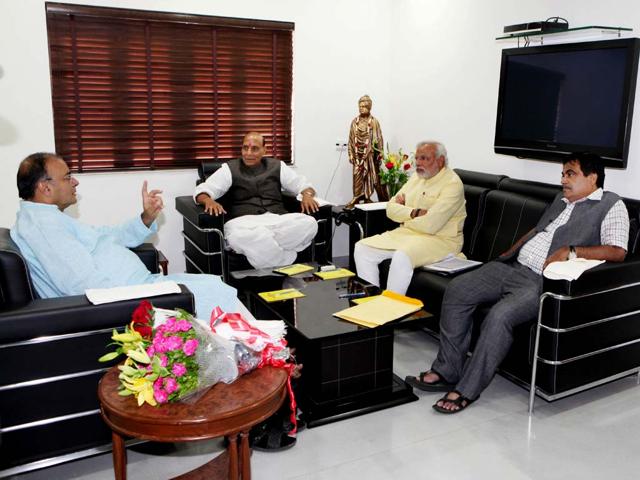Jobs, inflation, growth: It’s time to get cracking
In ordinary times, a budget should not be a platform to list and introduce comprehensive policy changes. This, however, is not an ordinary year. With the budget a month away, HT presents a draft of what we would like to hear from the new FM.
Madam Speaker/ Mr Speaker Sir,

In ordinary times, a budget should not be a platform to list and introduce comprehensive policy changes. This, however, is not an ordinary year. The economy, which till recently was touted to emerge as a regional titan rivalling China, both in terms of size and rapidity of expansion, is now snowed under a raft of problems.
The backdrop
The real economy’s recent record has been anything but spectacular.
Industrial output fell 0.5% in March. Capital goods output — a proxy for investment activity — contracted 12.5% during the month, mirroring how companies aren’t adding capacity lines, hit by weak demand, high loan rates and costly raw materials.
Households putting off spending are early warning signals for the onset of an economy-wide squeeze. Elevated prices have hurt family budgets hard, especially at a time when thousands of companies have offered meagre salary hikes and are holding back expansion and hiring.
That consumer durables output fell 11.2% in March mirrors this trend.
The inflation numbers also underline the fragility of the real economy. India’s retail inflation rose to a three-month high of 8.59% in April on high vegetable and food prices.
That said, while the economy is wobbly, it is not falling off a cliff. All is not lost yet.
If 2013-14 will be remembered for slumping growth, high cost of living, poor salary hikes and shooting equated monthly installments (EMIs), 2014-15 and the next couple of years may well define the story of Indian economy’s great come-from-behind innings. This would require a bit of political will and some decisions that may hurt in the short-term.
Implement, implement, implement
From overstretched airports to heavily-congested roads, and strained capacity at ports, India’s creaky infrastructure is in striking contrast to the image of a country that is aspiring to be a global economic superpower.
Projects worth more than Rs 100,000 crore are running late because of pending clearances at ministries and departments.
These projects can build thousands of kilometres of highways and connect hundreds of kilometres in the country through India’s vast railway network, besides spinning thousands of new jobs.
Quick decision-making and speedier implementation are vital to overhaul India’s collapsing infrastructure, which, if built, could catalyse every sector, from farm to factory, spin jobs and multiply incomes.
The time to put all major projects beyond a certain threshold on a strict implementation plan, with stringent penalties on time overruns, has arrived.
Fiscal rectitude
A roadmap drawn up in 2012 had committed to reduce India’s fiscal deficit to 3% of gross domestic product (GDP) in five years. Taming of the twin deficits — current account and fiscal gaps — are critical for the overall health of India’s public finances.
The tendency to give fiscal rectitude a pause runs strong in India, particularly for a new government, but there should be no let up on the focus on fiscal discipline, even if it comes at the cost of an expenditure pruning in some programmes, which need an intelligent re-design.
The spectre of a downgrade looms large over the economy, and at no cost can the India’s sovereign rating be allowed to be relegated to “junk” status. Deficits, by definition, are function of income and expenditure.
In a period of sliding income and slow growth, expenditure tightening is always a better way keep budget gaps under check.
Tax reforms
One of the surest ways to revive a sagging economy is to prompt households to spend more on —both essentials and aspirational — purchases.
In times of high prices, the best way to achieve that is by raising disposable income through tax breaks.
It is now about time to iron teething glitches and introduce two of India’s biggest reforms initiatives—the Direct Taxes Code (DTC) and the Goods and Services Tax (GST).
The Parliamentary standing committee had recommended raising the income tax exemption limit to Rs 3 lakh from the current Rs 2 lakh per annum.
Raising the income tax exemption limit will give more money in people’s hands. The resultant rise in spending will, in all likelihood, spur spending and eventually raise investment.
Likewise, GST is India’s most ambitious indirect tax reform plan, which aims to stitch together a common market by dismantling fiscal barriers between states, and there can be no argument against it.
From a foreign investors’ darling to a slowing economy prone to risky policy flip-flops, the turnabout of India’s image has been as rapid as the sizzling growth it had once peaked during 2004-08.
The budget can be the perfect starting point to turn it around.
Stay informed on Business News, TCS Q4 Results Live along with Gold Rates Today, India News and other related updates on Hindustan Times Website and APPs



